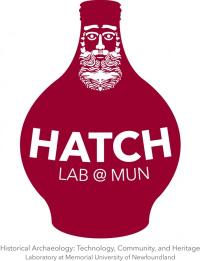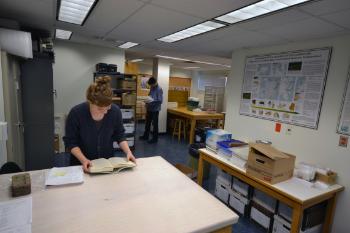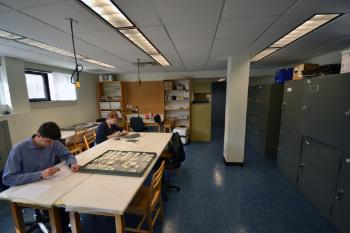Historical Archaeology Laboratory

The Historical Archaeology: Technology, Community, and Heritage (HATCH) laboratory at Memorial is dedicated to three main principles that guide its researchers in the study of historical archaeology: technology, community and heritage.
By understanding the recent past through the technology seen in the artifacts, structures, and landscapes left behind by people who used them, researchers explore how colonization and globalization affected Atlantic communities during the last 500 years. The HATCH team employ a broad range of field and laboratory methods including archaeological excavation, geophysical survey, GIS modelling, RTI and photogrammetry as well as quantitative and qualitative analyses of ceramics, glass, clay tobacco pipes, metals and faunal remains.
Enduring partnerships with communities is a central pillar of the HATCH team. Some have been ongoing for over 20 years. These community-university partnerships involve museums, municipalities, various foundations and local historical societies. Some of our collaborators include the Colony of Avalon Foundation, The French Shore Historical Society, The Carbonear Heritage Society, The Town of Sunnyside, The O’Brien Farm Foundation, The Fisheries Museum of the Atlantic, the Musée de Bretagne, The Admiralty House Museum and Archives, AIMARA (heritage association based in French Guiana), Service d’archéologie de Guyane, the Association pour la Sauvegarde du Patrimoine de l’Archipel, musée de l’Arche (both in Saint-Pierre et Miquelon) as well as individuals from all over the province and the world.
Community collaboration, integration, and cooperation in all aspects of our research, place the HATCH Lab at the forefront of applied historical archaeology.
Together, technology and community enhance the HATCH Lab’s overarching goal – to expand our knowledge, appreciation, and protection of our shared heritage. Through research on themes such as Lord Baltimore’s first trans-Atlantic colony, trans-Atlantic trade networks, the diverse expressions of colonialism in the former French colonies, early cod fishery, French migratory fisheries in northern Newfoundland, historic European transhumance, vernacular architecture, and eroding historical sites, the HATCH team is a leader in studying historical archaeology of the Atlantic world and understanding new socio-cultural contexts forged by colonial and post-colonial processes.
Contacts
- Dr. Barry Gaulton: historical archaeology; vernacular architecture; material culture; military archaeology; non-pastoral European transhumance; Eastern North America and Newfoundland.
Email: bgaulton@mun.ca - Dr. Catherine Losier: historical archaeology, French colonies, Atlantic colonial world, material culture studies, cultural interactions, colonial economies.
Email: closier@mun.ca

Current Projects
Dr. Barry Gaulton
- Ferryland Archaeology Project. In partnership with the Colony of Avalon Foundation. (Funded by SSHRC, ACOA, Department of Tourism, Culture and Recreation Province of Newfoundland and Labrador, and Memorial University of Newfoundland).
- Avalon Historic Petroglyph Project (Funded by the Department of Business, Tourism, Culture and Rural Development, Government of Newfoundland and Labrador).
Dr. Catherine Losier
- On the “Cod Road”: Saint-Pierre et Miquelon and the Atlantic Network of the 17th – 19th century. This project is documenting the impact of peripheral French territories, with a focus on Saint-Pierre et Miquelon, and their maritime networks on the colonial Atlantic world (Funded by SSRCH Insight Grant, ACOA-Coopération Régionale, DCSTEP-Saint-Pierre et Miquelon and Collectivité Territoriale de Saint-Pierre et Miquelon).
- La poterie des Jésuites: Ceramic production and cultural interactions in French Guiana during the 17th and 18th centuries (Funded by DAC-Guyane and Service d’archéologie de la Guyane).

Equipment and Facilities
The HATCH Lab contains the tools, space, and equipment for its researchers to conduct field- and lab-based research. Partnerships with institutions like the Colony of Avalon Foundation and the Fisheries Museum of the Atlantic provide HATCH Lab users with access to off-site facilities including additional space for analysis. The HATCH Lab contains:
- Peter Pope Library (containing hundreds of primary and secondary source documents and journals pertaining to the history and archaeology of the North Atlantic World). Graciously gifted by the family of the late Dr. Peter Pope.
- 168.5 square feet of table and layout space (2 laboratories).
- 16 28x37x32 inch artifact storage cases.
- Topcon GTS-105N total station and other survey equipment.
- Cataloguing and GIS computer stations with a printer and a large flat bed scanner.
- Light box and photography equipment.
- Artifact analysis equipment, including a drying and sorting rack.
- Several full sets of excavation gear including shovels, screens, knee pads, and dig kits.
Aubrey O'Toole, Ph.D student
Robyn Lacy, Ph.D student
Adrian Morrison, Ph.D student
Bryn Tapper, Ph.D student
Susana Vallejos, Ph.D student
JD Archer, M.A. student
Eileen Bethune, M.A. student
Mallory Champagne, M.A. student
Jake De La Plante, M.A. student
Robynn Hoskins, M.A. student
Natasha Jones, M.A. student
Meghann Livingston, M.A. student
Karen Northover, M.A. student
Carli Perri, M.A. student
Colleen Tamblyn, M.A. student
Post-Doctoral Scholars
- Crompton, Amanda (2014). (Memorial University of Newfoundland), Habitants on the Chapeau Rouge: Documentary, Cartographic, and Archaeological Explorations of French Residence on Newfoundland’s Burin Peninsula.
- Manuel Casimiro, Tania (2013). (Universidade Nova de Lisboa), Portuguese Faience in North Atlantic Trade (17th-18th Centuries).
- Lyttleton, James (2010). (University College Cork), English Colonial Settlement in the North Atlantic World: The Calvert Estates in Ireland and Newfoundland in the Seventeenth Century.
- Hodgetts, Lisa (2003). (University of Western Ontario), An Examination of Early English Colonial Diet at Ferryland, Newfoundland.
Doctoral Graduates
- Miller, Aaron (2013). Avalon and Maryland: A Comparative Historical Archaeology of the Seventeenth-Century New World Provinces of the Lords Baltimore (1621-1644).
- Crompton, Amanda (2012). The Historical Archaeology of a French Fortification in the Colony of Plaisance: the Vieux Fort Site (ChAl-04), Placentia, Newfoundland.
- MacLeod-Leslie, Heather (2011). Sankofa -- Return and Get It: An Archaeological Exploration of Black Loyalist Identity and Culture in Nova Scotia
M.A. Graduates
- Spiwak, Alexa (2020). "A slator or two": Exploring the 17th-century slate industry at Ferryland.
- Petty, Ian (2019). "As Elegant as They are Novel": Exploring Consumption Patterns of 18th Century Ceramics in Newfoundland and the Northeast.
- Jones-Doyle, Annique (2019). Maritime Consumption on Newfoundland’s Petit Nord: Material Expressions of Identity on the Champ Paya Fishing Station, 1504-1904.
Williams, Duncan (2019). ‘A Large House on the Downs’: Household Archaeology and Middle-Class Gentility in Early 19th-century Ferryland, Newfoundland. - Newcombe, Simon (2017). An Examination of Military Life in 18th-Century Newfoundland Using the Archaeological Remains of an Officer’s Barracks on Bois Island, Ferryland.
- Venovcevs, Anatolijs (2017). Not Just Fisherfolk: Winter Housing and the Seasonal Lifeways of Rural Euro-Newfoundlanders.
- Ingram, Sarah (2015). “By Which so Much Happiness is Produced”: An Analysis of the Seventeenth-Century Kirke Tavern at Ferryland, Newfoundland.
- Tapper, Bryn (2015). An Archaeological Analysis of the Distribution of French Fishing Rooms on the Petit Nord, Newfoundland.
- Lock, Hilary (2013). Exploring an Anglophone Presence at the French Fishing Room, Champ Paya, at Dos de Cheval (EfAx-09) in Cap Rouge Harbour, Newfoundland.
- Wolfe, Kara (2013). Culture Contact in Southern Labrador and Newfoundland's Great Northern Peninsula: An Ethnohistorical and Archaeological Approach.
- Clausnitzer Jr, Arthur R. (2011). “As Well as Any Beere": The Seventeenth-Century Brewhouse and Bakery at Ferryland, Newfoundland.
- Cromwell, Thomas E.G.S (2011). The New Fort: An Examination of the Design and Construction of an 18th-Century Fort in Placentia, Newfoundland.
- St John, Amy (2011). An Interpretation of French Ceramics from a Migratory Fishing Station at Dos de Cheval, Crouse, Newfoundland (EfAx-09).
- Noël, Stéphane (2010). Fishermen’s Foodways on the Petit Nord: Faunal Analysis of a Seasonal Fishing Station at the Dos de Cheval Site (EfAx-09), Newfoundland.
- Tavernor, Joshua (2010). Early Newfoundland and the Atlantic World: Import to Newfoundland in the Late Seventeenth and Early Eighteenth Centuries.
- Burns, Mélissa (2009). Symbols of the French Presence in Newfoundland: Breton Crosses and Calvaries - 1680 to Today.
- Jones, Jennifer (2009). Pêcheurs, paturages et petit jardins: A Nineteenth-Century Gardien Household in the Petit Nord, Newfoundland.
- Jacobsen, Tava (2009). A View of Folk Pottery’s Muddy Past as Seen through Clay: An Analysis of Ceramics Found at the Historical Caldwell Pottery Factory Site in Arrow Rock, Missouri.
- Tourigny, Eric (2009). What Ladies and Gentlemen Ate for Dinner: The Analysis of Faunal Material from a Seventeenth-Century High Status English Household, Ferryland, Newfoundland.
- Godbout, Geneviève (2008). Breton Bread Ovens of the Petit Nord: the Archaeological Landscape of Foodways in the French Fishing Stations of Newfoundland.
- Newstead, Sarah (2008). Merida No More: Portuguese Redware in Newfoundland.
- Brandon, Nicole (2007). 17th and 18th-c. Stonewares from Ferryland, Newfoundland.
- Hranka, Teal (2007). An 18th-century Household at Ferryland.
- Leskovic, Barb (2007). A Rural Drinking Establishment in 18th-c. Ferryland, Newfoundland.
- MacIntyre, April (2005). Domestic Architecture in Nova Scotia and the McLeod Homestead.
- Cary, Henry (2004). Hoffnungsthal: 18th c. Moravian Mission at Nisbet Harbour, Labrador.
- Temple, Blair (2004). Somerset and Dorset Ceramics at 17th-Century Ferryland.
- Stoddart, Eleanor (2000). 17th-Century Tin-glazed Earthenware from Ferryland.
- Nixon, Douglas (1999). A 17th-Century House at Ferryland, Newfoundland, CgAf-02, Area B.
- Wicks, John (1999). 17th- and 18th-Century Bottle Glass from Ferryland, Newfoundland.
Undergraduate Honours
- Cole, Johanna (2019). Invisible Women: An Archival Approach to Unearthing the Historic Sex Trade in St. John’s, Newfoundland (co-supervisor Dr. Madeline Mant).
- Barras, Maryssa (2018). Exploring the Archaeological Potential of Saint Pierre, Saint Pierre and Miquelon.
- Champagne, Mallory (2018). "Woe to them rocks": Trade routes, Provisioning, and Material Culture in 17th - 20th century, Saint-Pierre.
- Osmond, Jazpyn (2018). The Archaeology of Internment: The Great War's impact on North America and Europe.
- Miller, Mikayla (2013). Examination and Interpretation of Architectural Remains of Structure 32, Ferryland, Newfoundland.
- Whalley, Meaghan (2013). The Conservation of Nineteenth Century Waterlogged Archaeological Cork.
- Graham, David (2012). Where Once They Stood...and Dropped Things: Answering Questions about Frenchmen's Island (ClAl-1) Through an Artifact Analysis.
- Halley, Shannon (2012). ‘For Whatever Ails Ya’ Glass Artifacts Analysis of Carbonear, Newfoundland.
- Hawkins, Catherine (2012). English Border Ware Ceramics at Ferryland, Newfoundland.
- Matte, Sarah (2011). Telling Time in Seventeenth- and Eighteenth-Century Colonial North America.
- DeRoo, Tessa (2009). All the King's Ponies: The story of Ferryland's Horses as Told by Their Furnishings.
- Elwood, Kathleen (2009). Sparking an Interest in the Past: An Examination of the Seventeenth- and Eighteenth-Century Gunflints from Ferryland, Newfoundland.
- James, Margaret (2009). Death and Christianity in the New World: An Examination of Christian Burials in 17th- Century Atlantic Settlements.
- Gushue, Jennifer (2008). Concerning the Healthfulness of this Countrie: Health, Hygiene and Medical Practices in seventeenth-century Newfoundland.
- Feltham, Jessica (2007). Early European Settlement in Shoal Harbour.
- Collins, Duane (2005). The Inshore Boats of Newfoundland: an Archaeological Perspective.
- Simms, Peter (2005). Where Are We Again? A Spatial Analysis of Selected French Fishing Stations on the Petit Nord.
- Brosnan, Thomás (2003). 18th-Century Material Culture from 327 Water Street, St John’s.
- Psathos, Regeena (2003). 17th-century Tin-glazed Earthenware from Mount Pleasant, Placentia.
- Murphy, Catherine (2002). Dating of the Domestic Structure of ChA1-4, Mt Pleasant, Placentia.
- King, Penny (2001). Normandy Stoneware from DdBt-2 and EjAu-19 on the West Coast.
- Walsh, Michael (2001). 17th-c Contexts at 327 Water Street, St. John's (CjAe-08).
- Simmonds, Matt (2000). Ceramics from CjAe-32, Water Street, St John's.
- Temple, Blair (1999). 17th- and 18th-Century Ceramics from CjAe-08, 327 Water Street.
Community Collaborators
Admiralty House Museum and Archives
AIMARA (Rémire-Montjoly, French Guiana)
Canso Historical Society
Carbonear Heritage Society
C.A. Pippy Park Commission
Colony of Avalon Foundation
Fisheries Museum of the Atlantic
French Shore Historical Society (Conche)
Grandchain Commemoration Committee (Griquet-St Lunaire)
Musée de Bretagne (Rennes, France)
Placentia Area Archaeology Committee
Town of Sunnyside
Individual Collaborators
Dr. Anna Guigne (Northbank site)
Mr. Bill Hickey (Town of O’Donnells)
Mr. Keir Knudsen (Griguet-St Lunaire)